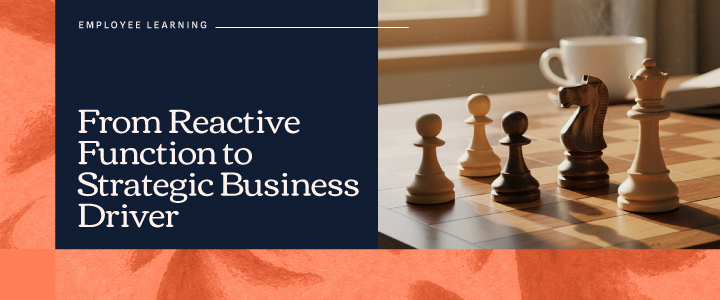
4 min reading time
The Confidence Gap: Is Employee Development the Secret to Keeping Your Best People?
What you’ll learn:
Employee development and confidence go hand in hand, and together, they’re one of the strongest drivers of retention. When people see a clear future with your company, they’re far more likely to stay. This article explores the “confidence gap” and why closing it matters for both employees and businesses.
Here’s what you’ll learn:
- Why employee confidence plays a critical role in retention.
- How development acts as a signal of trust and long-term investment.
- Practical strategies to boost confidence, from onboarding wins to career progression frameworks.
- The key metrics that connect employee development to real business impact.
Keeping great people isn’t about perks or pizza parties. Though let’s face it, no one’s turning down free pizza!
Instead, it’s about whether your employees believe they can grow in their role and with your company.
When employees don’t see a future with you, they start to question if they’re in the right place. That doubt creates what we call a confidence gap: the space between where they are today and where they believe they could be if the right opportunities were available.
The good news? That gap can be closed. And doing so is one of the most effective ways to keep your best people engaged, committed, and performing at their best.
Why Employee Confidence Is a Retention Strategy in Disguise
Confidence isn’t just a personality trait; it’s the result of having the right support, tools, and opportunities. When employees are confident in their abilities and their future, they’re far more likely to stay.
A lack of confidence, on the other hand, can quietly erode retention. If people feel underprepared, unclear on expectations, or uncertain about their path forward, even your most talented employees may start looking elsewhere.
Confidence is built when:
- Employees know exactly what’s expected of them.
- They have the knowledge (and the chance to apply it) to meet those expectations.
- They can clearly see how their career could progress with you.
That’s where employee development comes into play. It’s not just about improving performance today. It’s about creating a learning culture where growth feels possible at every stage of someone’s career.
What Makes Top Talent Stay? (Hint: It’s Not Free Lunch)
Yes, salary and flexibility matter. But as we’ve mentioned, retention is less about short-term perks and more about a consistent, long-term sense of progress.
A 2023 McKinsey study found that while work–life balance and compensation are among the top factors affecting the employee experience, employees themselves cite other characteristics that tend to be lower on employers’ lists. These include having caring leaders, doing meaningful work, and having a safe environment to work from.
When people feel supported and at ease in your company, they see more room for growth. They’re not just working for today’s paycheck—they’re building toward their future. That’s why employee learning and development, done well, isn’t just about creating courses. It’s about making learning feel like a natural part of work, and making it one of the most powerful retention strategies you have.
Employee Development as a Signal of Trust
There’s no doubt that investing in employee development strengthens business performance, but did you know that it also boosts morale and culture?
The right development programs tell your people:
- We believe in your potential.
- We see a future for you here.
- We’re willing to invest in that future.
This kind of support builds loyalty and confidence in ways perks never could. And it doesn’t require expensive programs or endless training days.
In fact, the most effective strategies are often:
- Realistic: Focus on learning that actually makes someone’s job easier today, while also preparing them for what’s ahead. When development feels relevant, people are far more likely to engage with it and experience the difference it makes to their day-to-day work.
- Scalable: Give everyone access to growth, no matter where they are. With the right tools (like an LMS), you can deliver a consistent, high-quality, and company-wide learning experience—without overloading your admin team.
- Personalized: Make it feel personal. A new hire, a seasoned specialist, and a future leader don’t need the same programs—so shape development around where each person is and where they want to go.
Closing the Confidence Gap: Quick Wins That Matter
You don’t need to rebuild your entire L&D strategy to start making employees feel more capable and supported. Small, intentional changes can quickly build employee confidence and show your commitment.
For example:
- Show the way forward: People feel more confident when they can see what’s next. So why not share what progression looks like in your company and the steps it takes to get there? Competency frameworks are a simple way to do this, taking the guesswork out of development and making expectations feel clear and fair.
- Make learning useful now: Learning sticks when it’s immediately relevant. Focus on knowledge employees can apply right away, and tie them to longer-term opportunities so programs feel both practical now and meaningful later.
- Give new hires early wins: First weeks matter. Equip new hires with the essentials they need to contribute from day one—whether that’s role-specific courses or quick-start resources—so they feel capable and engaged right away.
- Celebrate growth, not just results: Progress isn’t only about hitting KPIs. Call out when people take initiative to learn a new tool or step up to help a colleague. Even small moments of recognition can spark a huge confidence boost.
- Keep progress in plain sight: When growth is easy to see, it feels real, motivating, and worth investing in. Make development visible with tools that let employees track their progress and managers see who’s ready for more responsibility.
Confident Results: Proving Impact Through Employee Learning & Development
Employee confidence might feel hard to measure at first, but its effects show up loud and clear when you track the right things. When people trust in their abilities and see a future with your company, it changes how long they stay, how quickly they grow, and how much they contribute.
Some key indicators to track include:
- Retention rate: Are employees who engage in development programs staying longer?
- Internal promotion rate: Are employees moving up or into new roles rather than leaving?
- Time-to-productivity: Are new hires and internal movers reaching full performance faster?
- Progression: Are employees demonstrating greater responsibility and readiness for new challenges?
By linking employee learning and development metrics to business outcomes, you can demonstrate that confidence isn’t just good for morale; it’s good for business performance too.
Is Confidence the Key to Employee Retention?
The confidence gap is real — and it’s one of the most overlooked reasons businesses lose top talent. But by making development a consistent, visible, and personalized part of the employee experience, you can close that gap for good.
Want to see how LearnUpon can help?
Book a demo and discover how our LMS makes learning simple, engaging, and confidence-building from day one.



